ISMAR 2009 - was an extraordinary mix of high geek, academic eminence, gungho Dutch Cowboy entrepreneurial spirit, German engineering and industry, brilliant artistry, and invention, all fueled by a sense, and a very active presence in the case of Diamond Sponsor – Qualcomm, that the big technology players are waking up to augmented reality.
In the picture sequence above (click on photos to enlarge), Noora Guldemond, Metaio, demonstrates Junaio (coming to an iphone near you Nov 2nd) to Dirk Groten, CTO of Layar (top left photo). One of the nice social features of Junaio is that users can share the 3D augmented scenes they have created. Noora is demoing this capability to Dirk, and as you can see he cracks up when he sees the scene Noora has stored on her phone. Dirk and I both recognize that this cute little dinosaur augmentation (close up above on bottom left) must have been created by Peter Meier, CTO of Metaio, during the Interoperability and Standards workshop earlier that day. Metaio it seems were discussing standards while enjoying some 3D augmented back chat.
Both Dirk and I were active participants in the workshop too. But little did we know that Peter Meier had introduced his little 3D dinosaur into our discussion while we diligently, and sometimes heatedly, debated the merits of XMPP, Wave Federation Protocol, KML, ARML, VRML, X3D, and more! The photo I took is on the bottom right of the four pics above. It was probably taken very shortly after Peter’s augmented Junaio scene. Of course there is no little dinosaur in my pic of Dirk Groten with Joe Ludwig and Markus Tripp of Mobilizy who were discussing AR standards oblivious to Peter’s virtual pet in our midst.
I must say I had noticed an impish look on Peter Meier’s face (see photo above on the left – Peter is wearing glasses and holding a phone). And Markus Tripp, of Mobilizy revealed a little bit of gaming of his own, when he let out that, in part, ARML is a provocation. But Peter was clearly unfazed and enjoying himself. Dirk, tasked to summarize our discussion, stalwartly maintained an optimistic but serious tone fitting for a standards discussion: “There is a willingness to standardize….,” he began (pic above on left – click to enlarge and read text).
But it was a little 3D dinosaur that, perhaps appropriately, had the last laugh. Fitting, as I am not sure whether anything anyone says about AR standards at the moment will hold up. But, as Ori commented in his great post – an epilogue for ISMAR 2009, the vibe was “Peace and Love” in AR Browser land (although Chetan Damani of Across Air was not in the standards discussion because he attended the UX/content? workshop instead). But as they say, “all’s fair in love and war.” And it is my feeling the games have barely begun! There are many players (virtual pets included) waiting in the wings. I met some at ISMAR, and they are just itching to join the frey.
Ori Inbar, Ogmento and Robert Rice, Neogence Enterprises, both founders of the AR Consortium, made great efforts to set our young industry off on the right foot - in the spirit of coopetition (a neologism coined to describe cooperative competition). See Curious Raven for Robert’s conference observations, and Ori’s post on Games Alfresco for more about Mobile Augmented Reality at ISMAR 2009. The Mobile Augmented Reality Workshops were driven by an indomitable spokesperson for the new AR industry, Christine Perey. Christine not only helped motivate discussion on the issue of oxygen to the system, i.e. business value, but also she was a very generous connector at the conference.
What’s Next From Augmented Reality’s Top Chefs?
As Ori pointed out, Kent Demaine, oooii (pic above is from the oooii web site), Minority report VFX designer was hanging out at ISMAR 2009 and he came to the panel I was on: “Augmented Reality in Sports, Entertainment and Advertising.” We chatted afterwords about instrumented environments and how this is such a key to development interesting augmented experiences. Also I mentioned how back in the day I was involved in some of the early development of motion control software. And it was great to hear Kent say they were still finding motion control cool at oooii. As Ori notes, he is the “guy with the most enviable AR credentials in the world (the guy who designed VFX for minority report),” and oooii is busy and hiring.
One of the highlights of the Arts, Media and Humanities track for me was meeting Jarrell Pair. He really brought the best out in panelists with his well tuned questions. The recording of ISMAR was comprehensive and videos should be up next week. I will post the slides on Ugotrade of my presentation: “The Next Wave of AR: Shared Augmented Realities and Remix Culture.”.
“Mixed and Augmented Reality: ‘Scary and Wondrous’” – Vernor Vinge
“Imagine an environment where most physical objects know where they are, what they are, and can, (in principle) network with any other object. With this infrastructure, reality becomes its own database. Multiple consensual virtual environments are possible, each oriented to the needs of its constituency. If we also have open standards, then bottom-up social networks and even bottom up advertising become possible. Now imagine that in addition to sensors, many of these itsy-bitsy processors are equipped with effectors. Then the physical world becomes much more like a software construct. The possibilities are both scary and wondrous.” (Vernor Vinge - intro to ISMAR 2009)
Vernor Vinge’s short intro to ISMAR 2009 (which can be downloaded with the ISMAR 2009 schedule here) captures the essence of the “Scary and Wondrous” dawn of the age of ubiquitous computing and mixed and augmented reality. It is definitely worth a moment to download. The future of augmented and mixed realities, as Vernor Vinge points out, is tied up in a “tension between centralized and distributed computing” that “will continue long into the future.” One of my fascinations with Wave is that it offers a tantalizing opportunity to explore augmented reality in an open distributed architecture.
At ISMAR, I talked with as many people as possible about the AR Wave project – see my post here for more about Wave enabled AR. Many people were very enthusiastic to join the AR wave and the only thing I really lacked was about 100 invites to hand out!
“Everything, Everywhere – making visible the invisible”
Some of the areas that I would have liked to see given more attention on at ISMAR were sensor networks, data curation, and user experience. Not that these areas were entirely neglected with Pattie Maes, MIT as a keynote speaker, and Mark Billinghurst presenting on some fascinating work on social augmented experiences and user experience. I highly recommend catching up on these and other ISMAR presentations when the videos go up.
And, I was very happy to meet and talk to Sean White whose work at Columbia University is one of my inspirations (for more about Sean’s work see here or click image above):
“the confluence of powerful connected mobile devices, advances in computer vision and sensing, and techniques such as augmented reality (AR) enables exciting new opportunities for interacting with this hidden network of dynamic information and shifts the locus of interaction from the desktop computer to the world around us”
And I had several very interesting conversations at ISMAR about developing social augmented experiences that connect us to a physical world that is becoming “much more like a software construct” (Vernor Vinge). Dirk Groten, CTO of Layar mentioned a few interesting projects Layar has up their sleeves, including something Layar may be cooking up with The RoomWare Project.
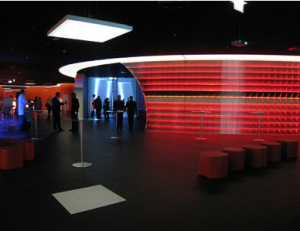
The picture above is of RoomWare’s Social RFID Installation for Media Plaza in Utrecht (read more here).
Demos Galore!
In the demo rooms, Noah Zerkin (pic below left) pretty much single handedly carried the AR flag for a growing community of augmented reality Makers and Hackers. But his presence was much appreciated, and he tirelessly demoed The Zerkin Glove. See the first of what may be several posts from Noah on ISMAR here.
And I got to try out the Vuzix goggles (picture above on right).  This was my first experience playing an AR game that was smart about real world gravity. It’s “an augmented reality marble game that uses gravity as a game controller” – see Ori Inbar’s write up here. It was a very compelling experience and I have to say I didn’t really notice the shortcomings of the Vuzix goggles while I was absorbed in the game. And I turned out to be quite good at the game too. It is intuitive unlike the kind of rule based games I never have time to learn properly. But what is so special about this project is the tools that it is built with are open, and available for all, and affordable (see this list on Games Alfresco).
It was a great pleasure to meet Prof. Steven Feiner (picture on below the left) who heads Columbia University’s brilliant AR research team at The Columbia University Graphics and User Interfaces Lab.
Ori Inbar (pic below on right) also spent a lot of time in the demo room showing off Ogmento’s lovely AR learning game that delighted attendees, “Put a Spell: Learn to Spell with Augmented Reality.â€
For a round up of what’s next for augmented reality head mounted displays check out, Games Alfresco here, and Thomas Carpenter’s excellent review of the head mounted displays.
Ori Inbar on Games Alfresco asks is “Microsoft – the new big player to watch?”  “Georg Klein, inventor of PTAM-on-an-iPhone (and the smartest Computer Vision guy on the block)” has joined Microsoft to make Mobile AR.
The picture on the left above shows Georg trying out ARhrrr with Blair MacIntyre.  And on the right Blair is demoing his marker card pack to Senior Vice President of Cypher Entertainment, David Elmekies. Yes ISMAR was abuzz with demos. See this post from Gail Carmichael for more video demos.
Next Year ISMAR 2010 in Korea!
At the banquet, I managed to find a seat at a table with Sean White (at left in photo above with Christine Perey to his right) and the Columbia University team. The banquet culminated with the “Past and Future of ISMAR†Panel chaired valiantly by Jay Wright of Qualcomm. We were asked to offer our input for ISMAR 2010. I offered up an idea that I have been nurturing for a while now - to stage a “Green Tech AR Competition.” Perhaps, I suggested, we could base the competition around a conference (ISMAR 2010 in Korea?) and set up a target rich, instrumented environment for the occassion. I think the Arduino open hardware community and AR developers have a synergy that is just waiting to be explored! And, if we add the innovators of data curation to the mix, e.g., Pachube, AMEE, and Path Intelligence…(Markus Tripp left ISMAR to speak on a Web 2.0 Summit panel, “Humans as Sensors,” which also included Path Intelligence, Deborah Estrin on “participatory sensing,” and the brilliant work of Di-Ann Eisnor, Platial, on “Transactional Cartography”). Anyway a big Green tech AR competition could get people working together across the broad spread of AR terrain on some of the sticky problems of user experience. And, with a high level of support from Smart Phone companies, HMDs manufacturers and the chip makers we just might come up with some extraordinary magic.
The devil of course will be in the details. But a competition like this could not only motivate key players to come together in the spirit of coopetition but also be an opportunity to show the world the power of AR to make visible the invisible ecosystems that are so important to the health of our planet.
One of the notable presences at ISMAR 2009 was the Qualcomm team.  Jay Wright’s presentation (an exclusive for ISMAR) not only outlined AR for 2012, but Jay also talked about some “close to the metal” innovation that we will see from Qualcomm very, very soon! I had some time in the press room with Jay and his team prompted by MoMo’s Yuri van Geest. When I twittered about Qualcomm’s presentation at ISMAR, Yuri replied:
vangeest “@tishshute: good stuff, hopefully you will integrate the neat new solutions and ideas in your talk in November ;)”
I will be presenting at MoMo #13 on AR, open AR, future of AR and GeoWeb, and hopefully will bring some good news from Qualcomm too. Anyway Jay seemed to like the idea of a Green Tech AR Competition, even though I did stress that I thought it needed some serious sponsorship and BIG prizes.
Where’s the beef? Tracking and Mapping at ISMAR 2009
On the flight from NYC to Orlando and ISMAR’o9 I dozed (I had been up late preparing my presentation) and I watched the Dew Tour Pro Skateboard competition and Top Chef on the Food Channel. In this particular episode of Top Chef, the aspiring chefs were all given a brown bag of ingredients by an already famous chef who then judged whether the contenders managed to make a delicious meal with their allotment which was notably lacking in key ingredients of haute cusine.
This metaphor of trying to cook up a great meal while perhaps missing the staples is apt for the current early stage of commercial augmented reality. And when I arrived in Orlando, not only were the Dew Tour pro skateboarders staying at the same hotel as ISMAR, but ISMAR itself felt remarkably like an Augmented Reality Top Chef Coopetition.
Much of ISMAR was dedicated to the task of providing the meat and potatoes of Augmented Reality, solutions to mobile tracking, mapping and registration, particularly in the Science and Technology track.
Industrial and Military Augmented reality solutions I found out, typically, solve the tracking problems by using fixed mounts which clearly wouldn’t translate well into the AR everywhere with everything mobile consumer culture expects.
In the picture on the left Fabian Doil stands by the VW engine that provided some of the outdoor targets for the ISMAR tracking competition. On the right is a picture from the VW’s presentation on their research and development of AR.
I followed the tracking contest, organized by Daniel Pustka and Fabian Doil of Volkswagen, quite closely. And I learned a lot in the process. While it is clear there has been progress in AR mapping and tracking, we still have a ways to go.
But hanging around the Tracking Competition was a good way to find out the state of play of this crucial part of the AR dream. For example, a little tidbit I learned is that Michael Goesele who has been reconstructing “high-quality geometry models from images collected from the internet (so called community photo collections, CPC)” is soon to be at the Institut Graphische Datenverarbeitung where top contenders in the tracking contest – Harald Wuest and Folker Weintipper (in the foreground of the photo at the left and right respectively) are also to be found. [update Harold and Folker were the winning team see here for details of scoring and results!] Otto Korkalo and Tuomas Kantonen of VTT, Finland, Augmented Reality team are in the background. They have been working on the joint IBM, Nokia and VTT project that brings, Avatars and People Together for Virtual Meetings in Physical Spaces.
The picture on the right is another team that were doing very well. If my notes serve me well (and please forgive me if they don’t. I came back with my card wallet overflowing!) the photo on the right showsChristian Waechter (on the left) and Peter Keitler (on the right) of the Technische Universitat Munchen.
Germany is certainly leading the way in industrial AR. And I learned how small businesses like Metaio get to work with top research institutions and big companies like VW, thanks to very strong German funding program for AR and VR. The current iteration of a series of funding programs is called Avilus. Avilus is putting 42 million Euros into AR and VR this year alone (click on the slide below to see more about Avilus ).
I wish we had the equivalent of Avilus here in the US. But there is no equivalent to Arvilus for AR here, and no AR is being developed by the US car industry either it seems. But look at the slide above to get a taste of some of the cool stuff Metaio and other small AR and VR businesses do for VW through the Avilus project.
I also got to meet many people from one of the world’s most important AR hubs - The Department of Informatics, Technische Universitat Munchen, including Prof. Gudren Klinker on the far right in pic above. And from left to right, Fabian Doil (VW, co-organizer of contest), Sebastian Lieberknecht , Selim Ben Himane (Metaio), Tobias Eble (Metaio). Prof. Klinker is the engine behind much of German innovation in AR.
Metaio was one of the few teams to rely mainly on markerless tracking which in this contest was very challenging because of the very different light conditions (see pics below) between the windowless interior and dazzling Florida sunshine outside (pic on the right shows targets under ideal lighting conditions). Many people in the US may be familiar with Metaio’s consumer applications, like Junaio, but thanks to Germany’s efforts to nurture augmented and virtual reality they are also respected software developers in industrial AR. And I suspect that Metaio will spearhead markeless tracking in consumer AR too.
This post as usual has already expanded to something much longer than I originally attended – pretty typical for me! There is much I have not been able to cover including some of the interesting contributions by augmented reality artists at ISMAR – again I recommend the upcoming videos.
But I cannot end without a hat tip to, Oriel, Nate et al. who won the best student paper award for AR Sketch – again please see Games Alfresco for more on this (pic below from Games Alfresco). AR Sketch, Ori notes, is featured “in our top post and popular video.” And
“Their work is revolutionizing the AR world by avoiding the need to print markers – or any images whatsoever.”

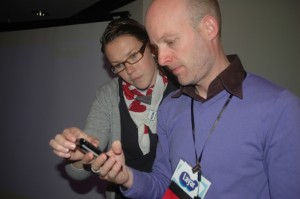
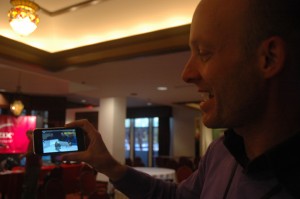
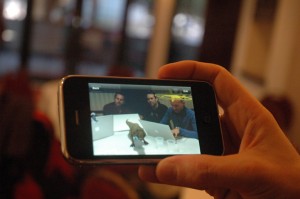
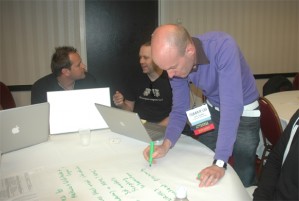
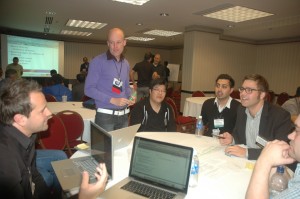
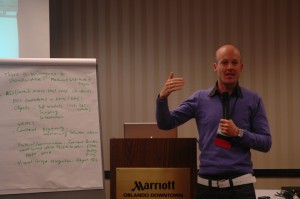
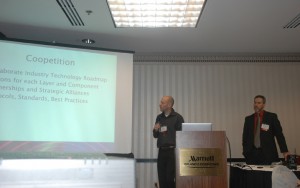
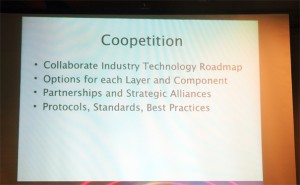
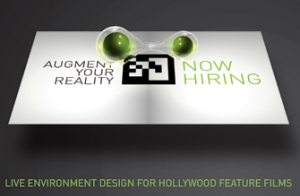
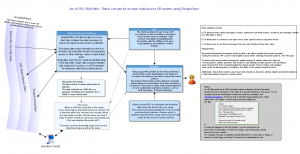

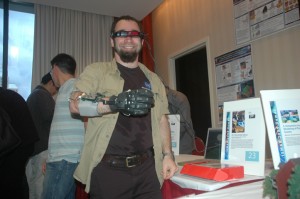
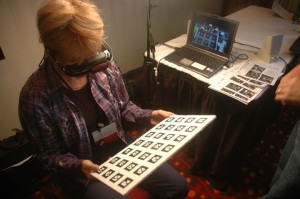
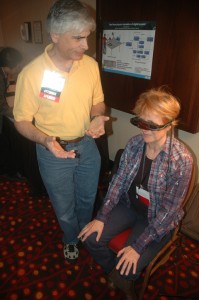
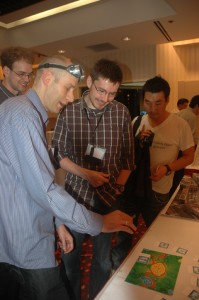
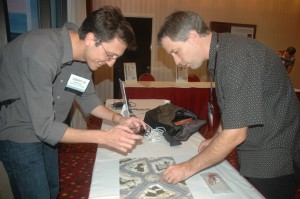
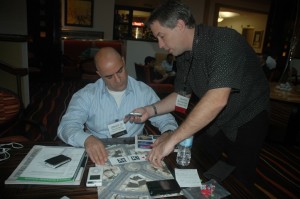

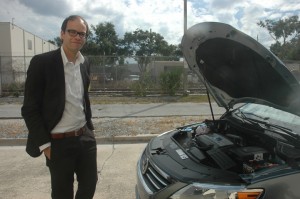
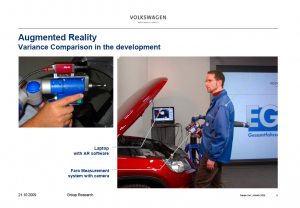
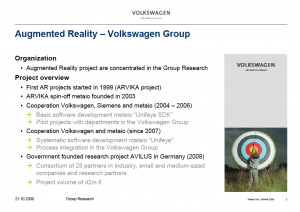
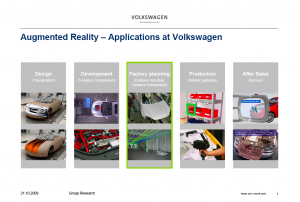
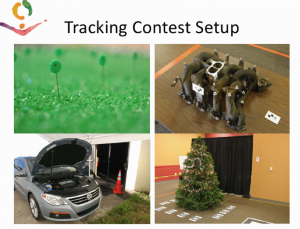
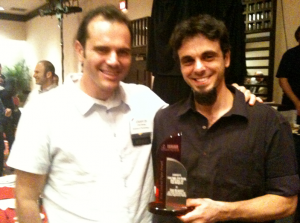
October 25th, 2009 at 3:39 pm
Great roundup Tish, thanks for applying your seemingly infinite energy to sharing your ismar09 experiences. I’m struck once again by the level of support that various European agencies, research institutes and companies are giving to connected world visions like AR, ubicomp, sensor nets, Internet of things. Encouraging to see Qualcomm stepping up as a US-based company, but so far very few of the US-based majors and certainly no govt agencies seem to be front and center. Silicon Valley feels like the third world of this next generation of connected tech…
October 27th, 2009 at 2:01 pm
Thanks, Tish! As always, your post helps ground out the hype and bring the most active players to light. Community building in this space will go a long way to reinforcing coopetition and standardization.
Also, I really like the idea of an ISMAR2010 AR Green Design Challenge.